Prediction of the Spatial and Temporal Adoption of an Energy Management System in Automated Dairy Cattle Barns in Bavaria—“CowEnergySystem”
Abstract
1. Introduction
1.1. Background Global Climate Change
1.2. Background to the “Stable 4.0” Research Initiative
1.3. Objectives and Problem Description in the “CowEnergySystem” Research Project
2. Materials and Methods
- (a)
- the application practice that influences its relative advantage,
- (b)
- the user population and its environment, which influence the perception of the relative advantage in practice,
- (c)
- the ease and speed of learning, which influence the willingness to use it in practice,
- (d)
- the potential user’s ability to put the application into practice.
3. Results
3.1. Main Results
3.2. Analysis of the Influence on the Acceptance Level
3.3. Analysis on the Influence on Adoption Duration
4. Discussion
4.1. Discussion of the Main Results
4.2. Discussion of the Learning Properties Category
4.3. Discussion Category Advantageousness
5. Conclusions
- (1)
- For the EMS in question, a market acceptance rate of 98% was calculated within the pre-defined user group and the diffusion period until maximum market penetration was estimated at 8 years. This is the first time that valid figures on the diffusion of this innovation have been presented.
- (2)
- However, when using ADOPT, it must be critically noted that in some cases the calculation algorithms and the variable weighting in the tool are not described in a sufficiently comprehensible manner. This puts the (comparatively very positive) overall result in a somewhat critical light.
- (3)
- In the in-depth impact analysis of the (2 × 2) variable categories used in the tool, individual main influencing factors such as “company size”, and “current and future benefit expectation”, were found to be significant for the intensity of adoption, indicating a need for further investigation. This finding is in line with the value drivers mentioned in the survey, which can directly and extensively influence a purchase decision. It will therefore be necessary for the project team to develop economic principles and the necessary framework conditions, especially for the economic added value, to provide farmers with reliable economic information about the EMS used, which can have a positive influence on the purchase decision.
- (4)
- The other references to the detailed results of individual factors, which provide an interesting statement on the spread of new technology, are also very useful. The analysis of the influencing factors and the measures derived from them is particularly important for developing a future marketing concept. The focus here is on both target-group-oriented and region-adapted advertising of the on-farm energy management system and the appropriate variable assignment in the tool.
- (5)
- Although ADOPT was originally designed purely for the agricultural sector, it is already being used for analyses outside the agricultural sector [28,29]. In comparisons, good correlations have already been established between the forecast results of ADOPT and practical figures, for example for automatic steering systems and direct sowing [26]. For example, factors influencing the introduction of photovoltaic systems for water pumping in Australian sugar cane irrigation systems have also been evaluated by the ADOPT tool [30].
Outlook
Author Contributions
Funding
Data Availability Statement
Acknowledgments
Conflicts of Interest
References
- Brodny, J.; Tutak, M. Assessing the Energy and Climate Sustainability of European Union Member States: An MCDM-Based Approach. Smart Cities 2023, 6, 339–367. [Google Scholar] [CrossRef]
- Lehmkuhl, D. Das Thema Klimawandel und seine Bedeutung im Gesundheitssektor: Entwicklung, Akteure, Meilensteine. Bundesgesundheitsbl 2019, 62, 546–555. [Google Scholar] [CrossRef] [PubMed]
- Gawel, E.; Paul, L.; Klaas, K.; Sebastian, S.; Jana, B.; Wolfgang, K.; Philipp, M.; Andreas, L.; Dominik, S.; Dörte, O.; et al. Die Zukunft der Energiewende in Deutschland. In Die Energiewende Verstehen-Orientieren-Gestalten; Nomos Verlagsgesellschaft mbH & Co. KG: Baden-Baden, Germany, 2017; pp. 425–446. [Google Scholar]
- Statistisches Bundesamt. Pressemitteilung Nr. N 016 vom 29. März 2022. Available online: https://www.destatis.de/DE/Presse/Pressemitteilungen/2022/03/PD22_N016_61.html (accessed on 28 November 2023).
- IEA. World Energy Outlook 2023, IEA, Paris. Lizenz: CC BY 4.0 (Bericht); CC BY NC SA 4.0 (Anhang A). 2023. Available online: https://www.iea.org/reports/world-energy-outlook-2023 (accessed on 28 November 2023).
- Klaus, T.; Vollmer, C.; Werner, K.; Lehmann, H.; Müschen, K. Energieziel 2050 Umweltbundesamt. Broschüre „Für Mensch &Umwelt. Seite 122. Available online: https://www.umweltbundesamt.de/publikationen/energieziel-2050 (accessed on 29 November 2023).
- Guillot, J.D. Europäisches Parlament. Artikel 30-10-2023-14:40 20200618STO81513. Available online: https://www.europarl.europa.eu/news/de/headlines/society/20200618STO81513/gruner-deal-schlussel-zu-einer-klimaneutralen-und-nachhaltigen-eu (accessed on 29 November 2023).
- Höwer, D.; Oberst, C.A.; Madlener, R. General regionalization heuristic to map spatial heterogeneity of macroeconomic impacts: The case of the green energy transition in NRW. Util. Policy 2019, 58, 166–174. [Google Scholar] [CrossRef]
- Spiecker, S.; Weber, C. The future of the European electricity system and the impact of fluctuating renewable energy—A scenario analysis. Energy Policy 2014, 65, 185–197. [Google Scholar] [CrossRef]
- Bartholdsen, H.-K.; Eidens, A.; Löffler, K.; Seehaus, F.; Wejda, F.; Burandt, T.; Oei, P.-Y.; Kemfert, C.; Hirschhausen, C.v. Pathways for Germany’s Low-Carbon Energy Transformation Towards 2050. Energies 2019, 12, 2988. [Google Scholar] [CrossRef]
- Lachmann, M.; Maldonado, J.; Bergmann, W.; Jung, F.; Weber, M.; Büskens, C. Self-Learning Data-Based Models as Basis of a Universally Applicable Energy Management System. Energies 2020, 13, 2084. [Google Scholar] [CrossRef]
- Marimon, F.; Casadesús, M. Reasons to Adopt ISO 50001 Energy Management System. Sustainability 2017, 9, 1740. [Google Scholar] [CrossRef]
- Gonçalves, V.A.; Mil-Homens dos Santos, F.J. Energy management system ISO 50001:2011 and energy management for sustainable development. Energy Policy 2019, 133, 110868. [Google Scholar] [CrossRef]
- Stumpenhausen, J.H. Bernhardt. On-Farm EMS|Praxisorientierte Erarbeitung Systemspezifischer Grundlagen für die Implementierung Eines Smart-Grid fähigen On-Farm Energie Management Systems für Milchviehställe mit Höchstem Automatisierungsgrad und Weitgehend Autonomer Versorgung über Dezentrale Regenerative Energieproduktion. 2013. Available online: https://www.hswt.de/forschung/projekt/765-on-farm-ems (accessed on 26 December 2023).
- Gaus, C.-C.; Minßen, T.-F.; Urso, L.-M.; de Witte, T.; Wegener, J. Mit Autonomen Landmaschinen zu Neuen Pflanzenbausystemen. Schlussbericht zu FKZ 14NA004 und 14NA011 Sowie 14NA012. Available online: https://orgprints.org/id/eprint/32438/1/32437_14NA004_011_012_thuenen_institut_de_Witte_Landmaschinen_Pflanzenbau.pdf (accessed on 15 October 2023).
- Lokhorst, C. An Introduction to Smart Dairy Farming; Hogeschool van Hall Larenstein: Leeuwarden, The Netherlands, 2018; 106p. [Google Scholar]
- Tedeschi, L.O.; Greenwood, P.L.; Halachmi, I. Advancements in sensor technology and decision support intelligent tools to assist smart livestock farming. J. Anim. Sci. 2021, 99, skab038. [Google Scholar] [CrossRef] [PubMed]
- Bernhardt, H.; Höhendinger, M.; Stumpenhausen, J. Development of the Technical Structure of the “Cow Energy” Concept. Agronomy 2021, 11, 1915. [Google Scholar] [CrossRef]
- Stumpenhausen, J.; Bernhardt, H. Integrated Dairy Farming-Ein Forschungsansatz für den Stall 4.0. Technik in Bayern; Verein Deutscher Ingenieure (VDI); MuP Verlag GmbH: München, Deutschland, 2019; pp. 12–13. [Google Scholar]
- Hartwig-Kuhn, S. Ein Energiemanagementsystem für den Milchviehhalter; LKV-Magazin; Landeskuratorium für tierische Veredlung in Bayern e.V.: Munich, Germany, 2021; pp. 15–18. [Google Scholar]
- Agrar-heute. Social Lab: Was Verbraucher von Landwirten Wollen. Available online: https://www.agrarheute.com/management/betriebsfuehrung/sociallab-verbraucher-landwirten-wollen-552428 (accessed on 19 September 2023).
- Bayerisches Staatsministerium für Ernährung Landwirtschaft und Forsten. Agrarbericht 2022. Available online: https://www.agrarbericht.bayern.de/landwirtschaft/produktionswert.html (accessed on 26 December 2023).
- Beinert, M. Projektstudie Energie-Management-System 2020. Nicht veröffentlicht. Hochschule Weihenstephan-Triesdorf. Available online: https://mobile.bedm.de/publication/Beinert_2020.pdf (accessed on 15 January 2024).
- Möhrle, M.G.; Specht, D. Diffusion. Wirtschaftslexikon Gabler. Springer Fachmedien Wiesbaden GmbH. Available online: https://wirtschaftslexikon.gabler.de/definition/diffusion-29314 (accessed on 30 September 2023).
- Möhrle, M.G. Innovationsbarrieren. Wirtschaftslexikon Gabler. Springer Fachmedien Wiesbaden GmbH. Available online: https://wirtschaftslexikon.gabler.de/definition/innovationsbarrieren-38557 (accessed on 30 September 2023).
- Kuehne, G.; Llewellyn, R.; Pannell, D.J.; Wilkinson, R.; Dolling, P.; Ouzman, J.; Ewing, M. Predicting farmer uptake of new agricultural practices: A tool for research, extension and policy. Agric. Syst. 2017, 156, 115–125. [Google Scholar] [CrossRef]
- López-Maciel, M.; Roebeling, P.; Llewellyn, R.; Figueiredo, E.; Mendonça, R.; Mendes, R.; Matos, F.; Bastos, M.I. The Use of the Adoption Prediction Outcome Tool to Help Communities Improve the Transition towards the Implementation of Nature-Based Solutions. In International Symposium: New Metropolitan Perspectives; Springer International Publishing: New York, NY, USA, 2022; Volume 482, pp. 2000–2011. [Google Scholar]
- Natcher, D.; Ingram, S.; Solotki, R.; Burgess, C.; Kulshreshtha, S.; Vold, L. Assessing the Constraints to the Adoption of Containerized Agriculture in Northern Canada. Front. Sustain. Food Syst. 2021, 5, 134. [Google Scholar] [CrossRef]
- López-Maciel, M.; Roebeling, P.; Llewellyn, R.; Figueiredo, E.; Matos, F.A.; Mendonça, R.; Bastos, M.I.; Mendes, R.; Postmes, L.; Van Dinter, M. Adoption and Diffusion of Nature-Based Solutions by Property Owners in Urban Areas: The Case of Green Roofs in Eindhoven, The Netherlands. Resources 2023, 12, 133. [Google Scholar] [CrossRef]
- Powell, J.W.; Welsh, J.M.; Pannell, D.; Kingwell, R. Factors Influencing the Adoption of Solar Photovoltaic Systems for Water Pumping by Australian Sugarcane Irrigators. In Proceedings of the 42nd Australian Society of Sugar Cane Technologists Conference 2021, ASSCT 2021, Bundaberg West, Australia, 20–23 April 2021. [Google Scholar]
- Kuehne, G.; Llewellyn, R.; Pannell, D.J.; Wilkinson, R.; Dolling, P.; Ewing, M. ADOPT: A tool for predicting adoption of agricultural innovations. In Proceedings of the Australian Agricultural and Resource Economics Society (AAERES), Melbourne, Australia, 8–11 February 2011. [Google Scholar]
- Halama, M. Bayerische Landesanstalt für Landwirtschaft, Institut für Agrarökonomie. Strukturwandel in der Landwirtschaft–Betriebsgröße. Available online: https://www.lfl.bayern.de/iba/agrarstruktur/295158/index.php (accessed on 26 December 2023).
- Paulsen, N.; Moritz, J. Schon 8 von 10 Landwirten Setzen auf Digitale Technologien. Bitkom Research 2020. Available online: https://www.bitkom.org/Presse/Presseinformation/Schon-8-von-10-Landwirten-setzen-auf-digitale-Technologien (accessed on 19 September 2023).
- Landeskuratorium der Erzeugerringe für Tierische Veredelung in Bayern e. V. München. Veredelung Milch/Milchleistungsprüfung in Bayern. 2022. S. 77. Available online: https://www.lkv.bayern.de/wp-content/uploads/2023/04/Jahresbericht_MLP_2022_FINAL_web.pdf (accessed on 30 December 2023).
- Bayerisches Staatsministerium für Ernährung, Landwirtschaft und Forsten. Schule und Beratung. Fachinformationen aus der Landwirtschaftsverwaltung in Bayern. 11-12/2022. S. 7. Available online: https://www.stmelf.bayern.de/mam/cms01/service/dateien/sub_heft_11_12_22_bf.pdf (accessed on 30 December 2023).
- Sundrum, A. Ökonomischer und ökologischer (Denk-)Ansatz. In Gemeinwohlorientierte Erzeugung von Lebensmitteln; Springer Spektrum: Berlin/Heidelberg, Germany, 2022. [Google Scholar] [CrossRef]
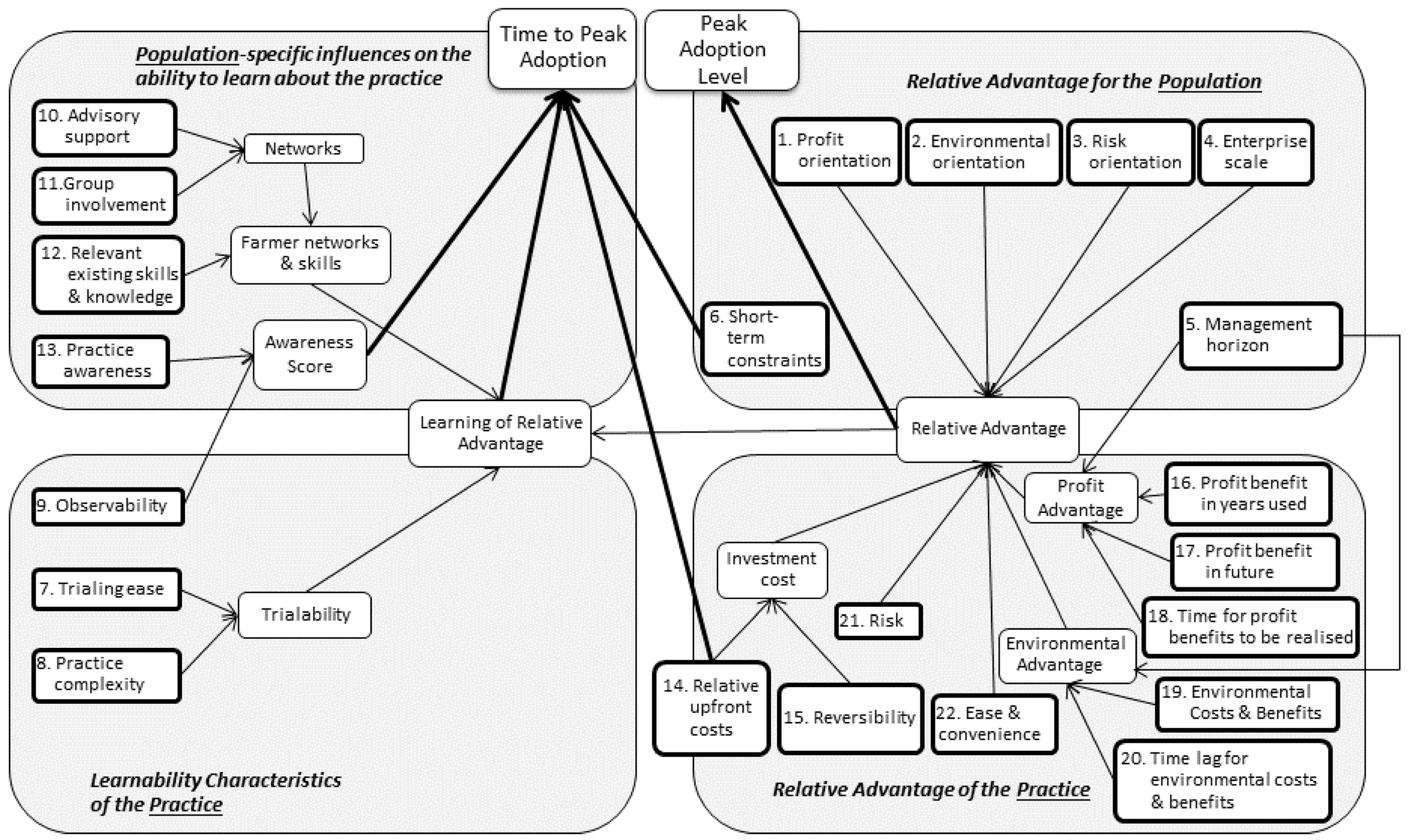
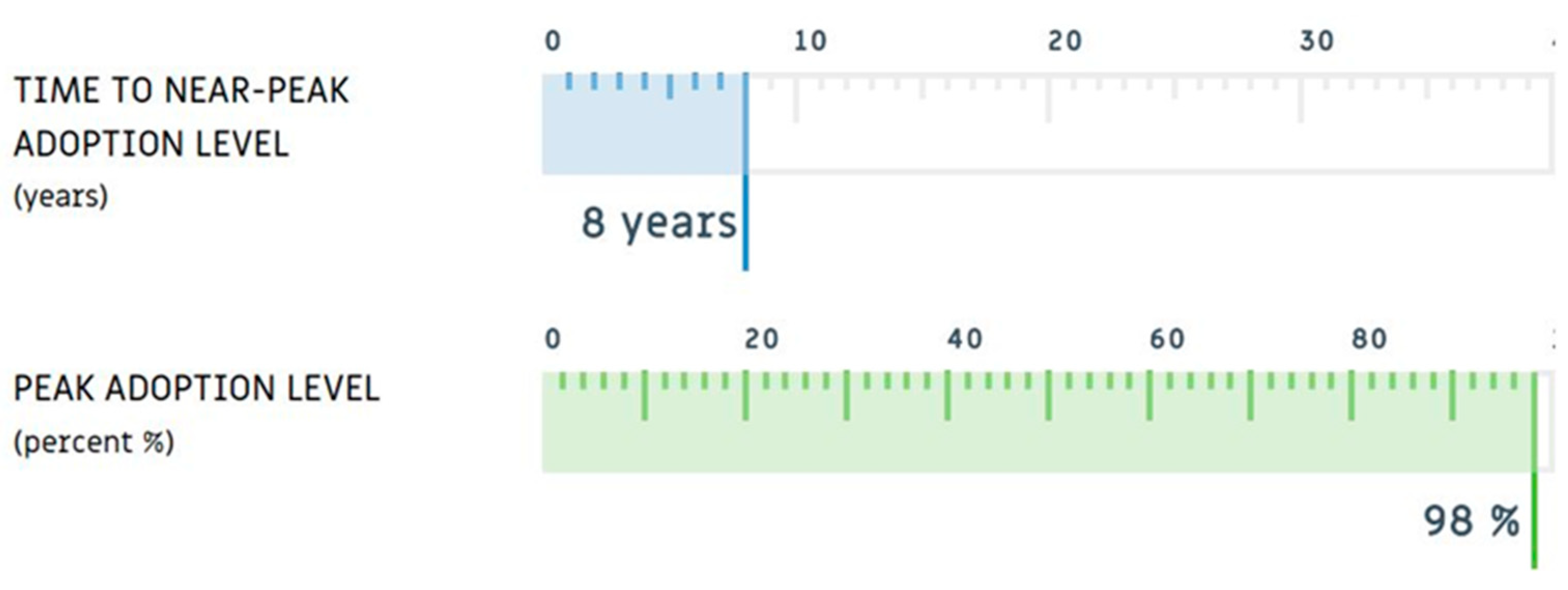



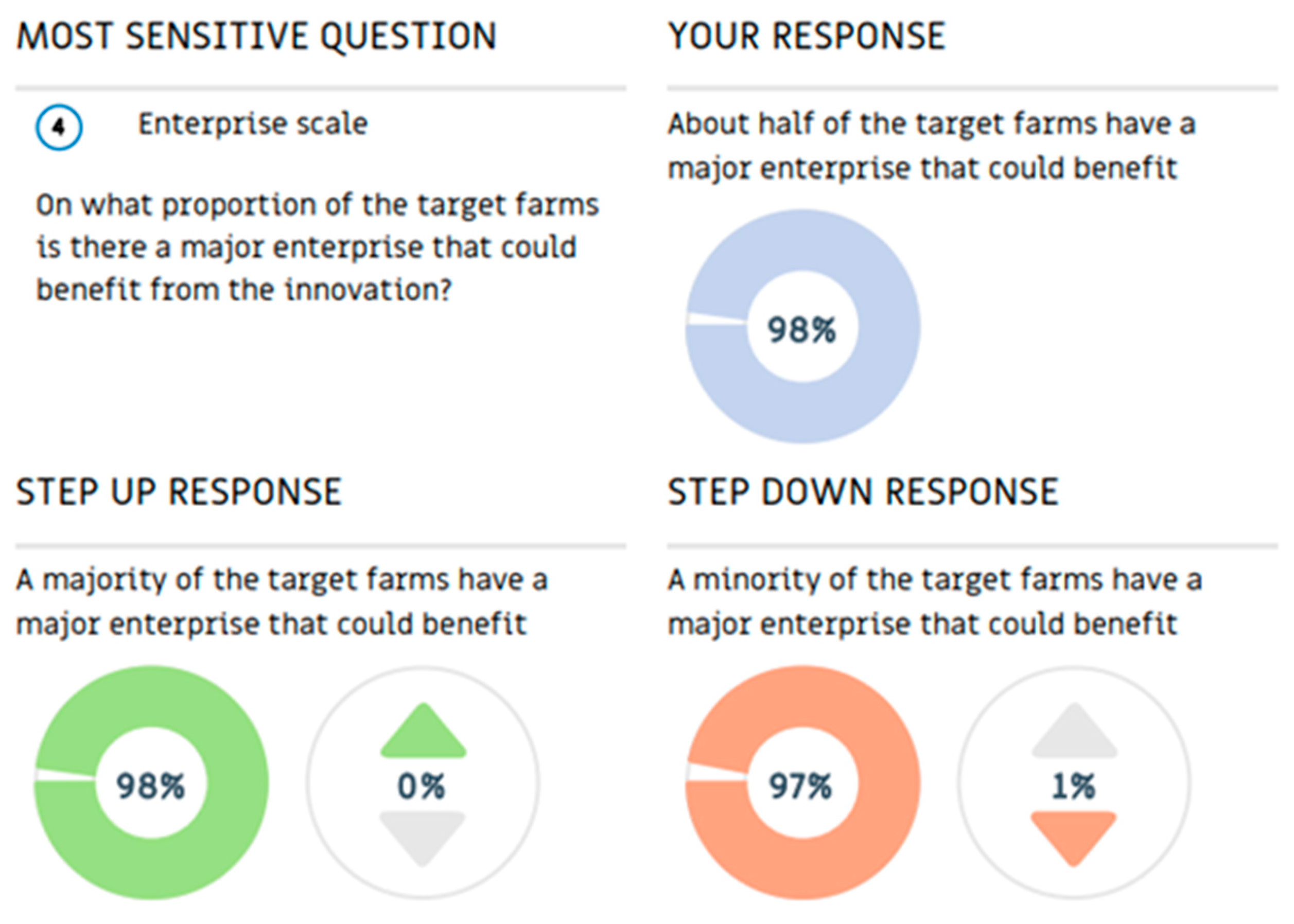
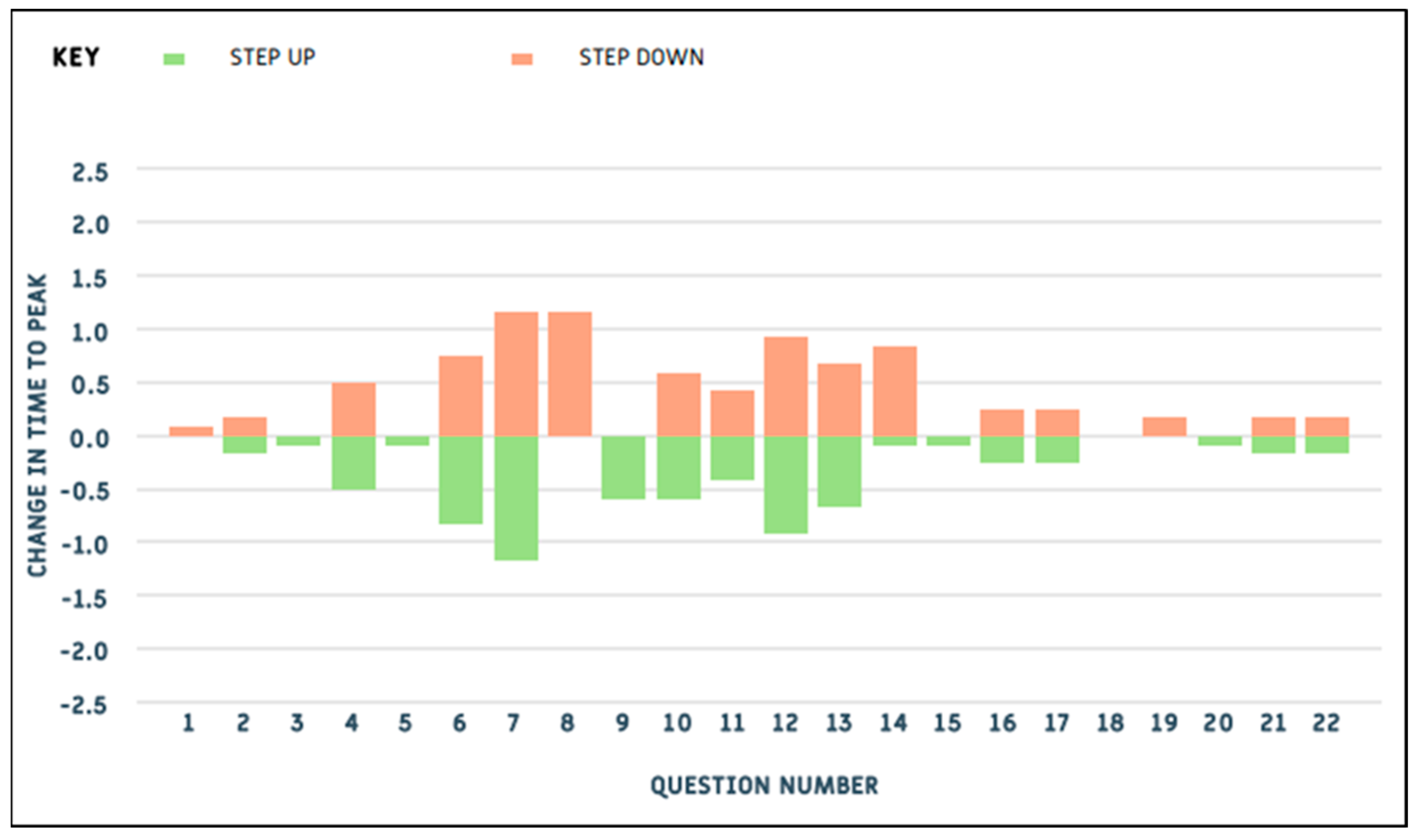
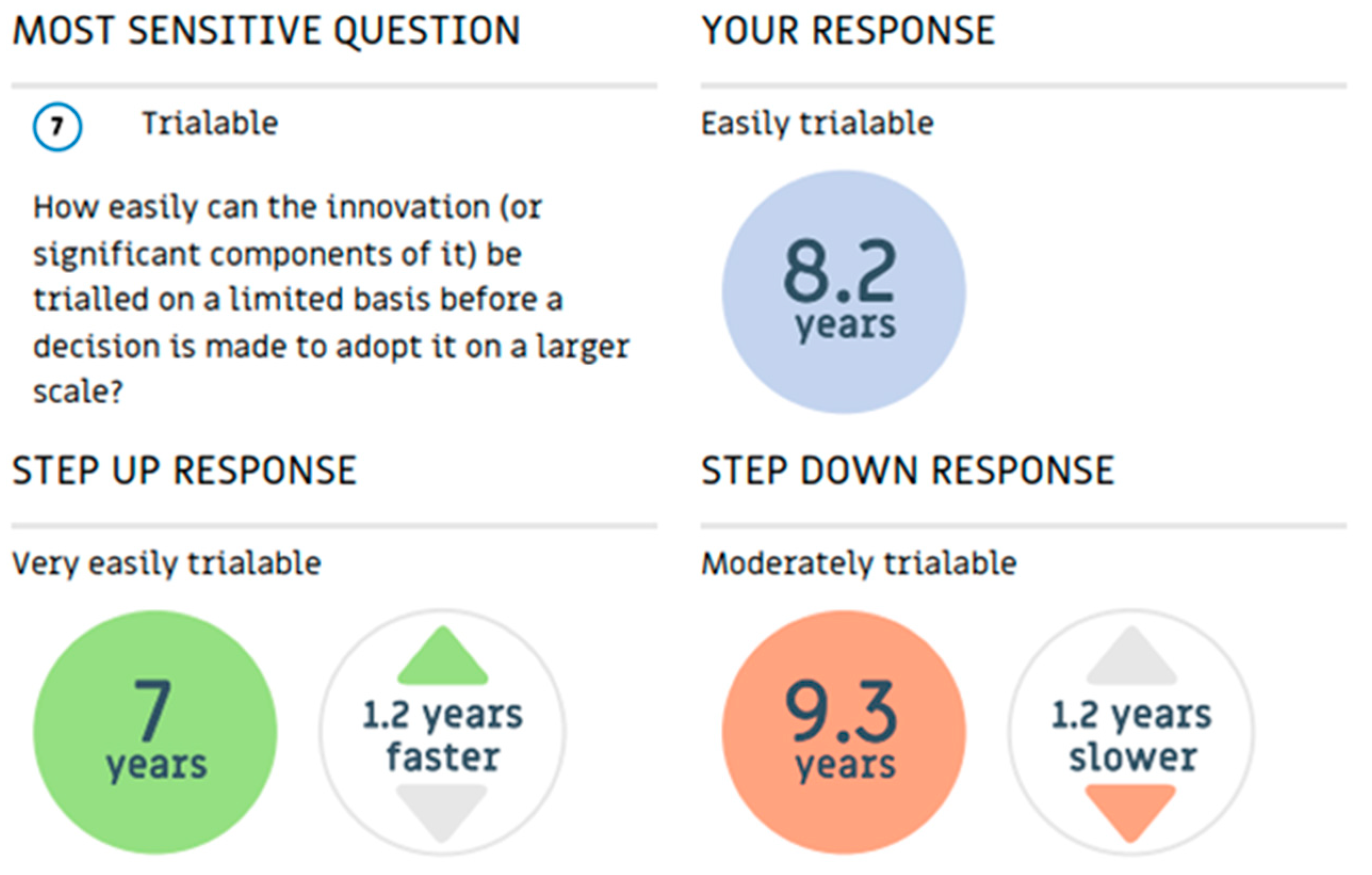
| Question | Response | Scaling |
|---|---|---|
| Relative Advantage for the Population | ||
| 1. Profit orientation | Almost all have maximising profit as a strong motivation | 5-(1-5) |
| 2. Enviromental orientation | About half have protection of the environment as a strong motivation | 3-(1-5) |
| 3. Risk orientation | A majority have risk minimisation as a strong motivation | 4-(1-5) |
| 4. Enterprise scale | About half of the target farms have a major enterprise that could benefit | 3-(1-5) |
| 5. Management horizon | A majority have a longterm management horizon | 4-(1-5) |
| 6. Short term constraints | About half currently have a severe short-term financial constraint | 3-(1-5) |
| Learnability Characteristics of the Innovation | ||
| 7. Trialable | Easily trialable | 4-(1-5) |
| 8. Innovation complexity | Not at all difficult to evaluate effects of use due to complexity | 5-(1-5) |
| 9. Observability | Not observable at all | 1-(1-5) |
| Learnability of Population | ||
| 10. Advisory support | About half use a relevant advisor | 3-(1-5) |
| 11. Group involvement | A majority are involved with a group that discusses farming | 4-(1-5) |
| 12. Relevant existing skills & knowledge | About half will need new skills and knowledge | 3-(1-5) |
| 13. Innovation awareness | A minority are aware that it has been used or trialed in their district | 2-(1-5) |
| Relative Advantage of the Innovation | ||
| 14. Relative upfront cost of the project | Moderate initial investment | 3-(1-5) |
| 15. Reversibility of the innovation | Difficult to reverse | 2-(1-5) |
| 16. Profit benefit in yearsthat it is used | Moderate profit advantage in years that it is used | 6-(1-8) |
| 17. Future profit benefit | Moderate profit advantage in the future | 6-(1-8) |
| 18. Time until any future profit benefits are likely to be realised | Immediately | 5-(1-6) |
| 19. Environmental costs & benefits | Very Large environmental advantage | 8-(1-8) |
| 20. Time to environmental benefit | Immediately | 5-(1-6) |
| 21. Risk exposure | Large reduction in risk | 7-(1-8) |
| 22. Ease and convenience | Large increase in ease and convenience | 7-(1-8) |
Disclaimer/Publisher’s Note: The statements, opinions and data contained in all publications are solely those of the individual author(s) and contributor(s) and not of MDPI and/or the editor(s). MDPI and/or the editor(s) disclaim responsibility for any injury to people or property resulting from any ideas, methods, instructions or products referred to in the content. |
© 2024 by the authors. Licensee MDPI, Basel, Switzerland. This article is an open access article distributed under the terms and conditions of the Creative Commons Attribution (CC BY) license (https://creativecommons.org/licenses/by/4.0/).
Share and Cite
Bader, C.; Stumpenhausen, J.; Bernhardt, H. Prediction of the Spatial and Temporal Adoption of an Energy Management System in Automated Dairy Cattle Barns in Bavaria—“CowEnergySystem”. Energies 2024, 17, 435. https://doi.org/10.3390/en17020435
Bader C, Stumpenhausen J, Bernhardt H. Prediction of the Spatial and Temporal Adoption of an Energy Management System in Automated Dairy Cattle Barns in Bavaria—“CowEnergySystem”. Energies. 2024; 17(2):435. https://doi.org/10.3390/en17020435
Chicago/Turabian StyleBader, Christoph, Jörn Stumpenhausen, and Heinz Bernhardt. 2024. "Prediction of the Spatial and Temporal Adoption of an Energy Management System in Automated Dairy Cattle Barns in Bavaria—“CowEnergySystem”" Energies 17, no. 2: 435. https://doi.org/10.3390/en17020435
APA StyleBader, C., Stumpenhausen, J., & Bernhardt, H. (2024). Prediction of the Spatial and Temporal Adoption of an Energy Management System in Automated Dairy Cattle Barns in Bavaria—“CowEnergySystem”. Energies, 17(2), 435. https://doi.org/10.3390/en17020435









